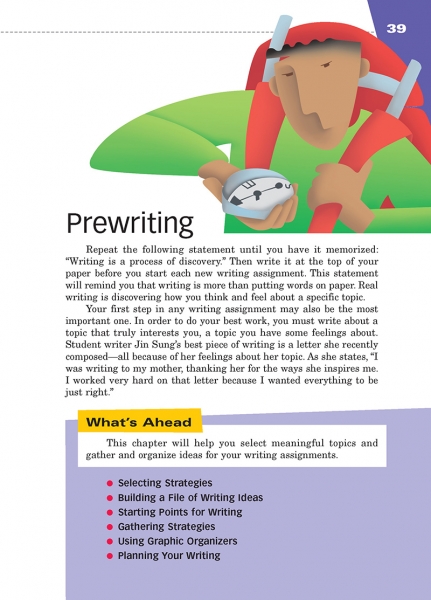Page 039 from

Start-Up Activity
Show videos of animals at play and ask students about what they are seeing:
-
A fawn frolics (leaps from spot to spot, kicking its hooves)
-
A kitten stalks (crouches in pursuit of a string or toy)
-
A puppy fetches (runs to grab something with its mouth)
Ask students why each animal plays in a different way. After hearing their answers, let them know each of these animals is practicing survival skills for adulthood. Deer must be able to leap and kick to avoid predators. Cats must be able to stalk and kill prey. And dogs have been trained by humans for thousands of years to fetch during the hunt. Each of these animals is messing around with skills before they are critical to have.
Let students know that prewriting is just like play. It's a chance to mess around with ideas before they count (before anyone is grading or criticizing them). In that way, prewriting shouldn't feel like a burden. Instead, it should feel like a chance to explore and have fun, getting ready for the seriousness of drafting.
Think About It
“Humanity has advanced, when it has advanced, not because it has been sober, responsible, and cautious, but because it has been playful, rebellious, and immature.”
—Tom Robbins

Start-Up Activity
Show videos of animals at play and ask students about what they are seeing:
-
A fawn frolics (leaps from spot to spot, kicking its hooves)
-
A kitten stalks (crouches in pursuit of a string or toy)
-
A puppy fetches (runs to grab something with its mouth)
Ask students why each animal plays in a different way. After hearing their answers, let them know each of these animals is practicing survival skills for adulthood. Deer must be able to leap and kick to avoid predators. Cats must be able to stalk and kill prey. And dogs have been trained by humans for thousands of years to fetch during the hunt. Each of these animals is messing around with skills before they are critical to have.
Let students know that prewriting is just like play. It's a chance to mess around with ideas before they count (before anyone is grading or criticizing them). In that way, prewriting shouldn't feel like a burden. Instead, it should feel like a chance to explore and have fun, getting ready for the seriousness of drafting.
Think About It
“Humanity has advanced, when it has advanced, not because it has been sober, responsible, and cautious, but because it has been playful, rebellious, and immature.”
—Tom Robbins





